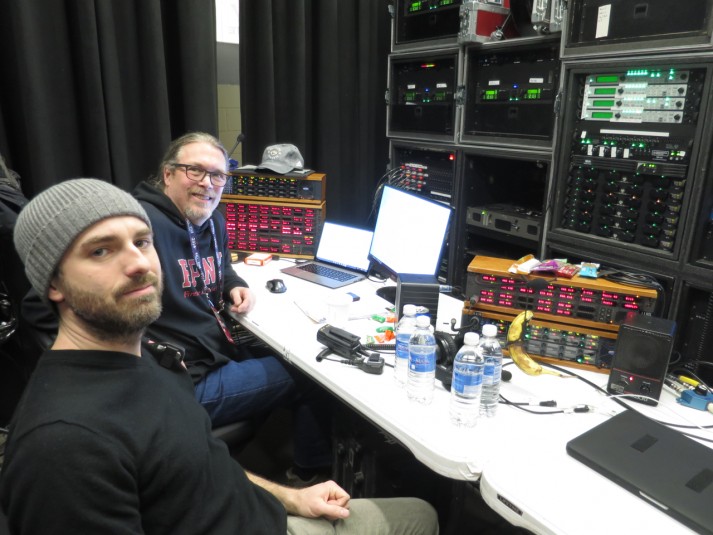Firehouse Shows Communications Artistry at NBA All-Star Weekend
Network integrates TV-production, live-entertainment, and in-house–production teams
Story Highlights
Firehouse Productions continues to play an expanding role in the NBA All-Star Weekend communications infrastructure, building out and maintaining a communications network based on the Riedel Artist digital-matrix intercom system.
All told, Firehouse managed almost 1,000 carriers, 90 channels of communications, and more than 400 communication devices, including hard-wired systems, master panels, and wireless beltpacks.

Firehouse Productions’ Vinny Siniscal (left) and Gaff Michael helped oversee a new, unified communications network at the NBA All-Star Game in Toronto.
This marked the third year that Firehouse was involved with the event, and the team included Gaff Michael, Riedel programmer; system architects Brian Hurst and Stephanie Celustka; and Luis Espinal, who handled wireless/communications integration.
“The first year, we originally came in to do the entertainment interfacing,” says Vinny Siniscal, RF, audio, and communications engineer, Firehouse Productions. “Then, last year, it was in New York City, where we were based on two sites, the Barclays Center in Brooklyn and Madison Square Garden in Manhattan; we doubled what we did the year before. And, this year, the scope expanded again, as things naturally do. This is now one of the largest shows in terms of the amount of intercoms.”
The major advance this year was tying in the Turner Sports intercoms, allowing anyone involved with a portion of the massive three-day event to easily communicate with anyone else. The Firehouse system basically pulled together communications from the TV-production team, the live-entertainment team, and even the in-house production team.
That is important for an event that is increasingly ambitious in terms of integrating in-venue entertainment programming with the TV broadcast, according to Chris Brown, senior director, technical operations, Turner Sports,
“For something as simple as light cues, our team can talk to the entertainment people so that they can know when the lights will come back up after going dark,” he explains. “A short conversation can get our team the lighting cues, and then they can even listen to the cues.”
Siniscal and a Firehouse Production team of nine staffers were based inside the Air Canada Center.
“We had one of our Riedel Artist frames inside an NEP truck to handle all truck-to-truck communications and then also connected that to the Artist frame [inside the arena],” adds Siniscal. “Everything in the building that needed to communicate could communicate.”
Firehouse Productions handles such systems for a wide range of clients, from the live hit during the Grammys of a performance of Hamilton to massive corporate events.
The distributed intercom-over-fiber system had full redundancy and was under the control of a simple graphical user interface that makes it easy for the Firehouse Productions team to meet the needs of each production team.
“This weekend was really three separate events: Friday, Saturday, and Sunday all had separate events with separate producers,” says Siniscal. “And all those different needs can be met with the push of a button to launch a file and change the whole system. It can morph from the slam-dunk contest to a concert and then to the All-Star game.”
Riedel not only provides the technical backbone but is also a kindred spirit in terms of corporate philosophy with respect to redundancy, reliability, and scalability. The company’s RockNet real-time, low-latency audio-distribution network is also put to use, allowing the Firehouse Productions team to build out a network for each unique situation.
“We can just keep scaling the standard package up,” adds Siniscal, “as it’s not a one-size-fits-all approach but scalable.”
